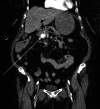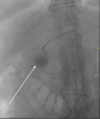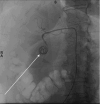Gastroduodenal Artery Pseudoaneurysm Causing Upper Gastrointestinal Bleeding
- PMID: 40799880
- PMCID: PMC12339424
- DOI: 10.7759/cureus.87799
Gastroduodenal Artery Pseudoaneurysm Causing Upper Gastrointestinal Bleeding
Abstract
Gastroduodenal artery pseudoaneurysms (GDAPs) are a rare but potentially life-threatening condition characterized by the formation of a blood-filled sac secondary to disruption of the arterial wall, frequently resulting from trauma, pancreatitis, or ulceration. We present the case of a 73-year-old female diagnosed with a GDAP of unknown etiology. Management included collaboration with the interventional radiology team for angiography and coil embolization. This case highlights the importance of early recognition and multidisciplinary management, including imaging, endovascular intervention, and surgical consideration.
Keywords: artery; bleed; egd; embolization; gastroduodenal; gastrointestinal; microcoil; non-steroidal anti-inflammatory drug; pseudoaneurysm.
Copyright © 2025, Abul-Khoudoud et al.
Conflict of interest statement
Human subjects: Informed consent for treatment and open access publication was obtained or waived by all participants in this study. Conflicts of interest: In compliance with the ICMJE uniform disclosure form, all authors declare the following: Payment/services info: All authors have declared that no financial support was received from any organization for the submitted work. Financial relationships: All authors have declared that they have no financial relationships at present or within the previous three years with any organizations that might have an interest in the submitted work. Other relationships: All authors have declared that there are no other relationships or activities that could appear to have influenced the submitted work.
Figures



References
-
- Systematic review of the incidence, presentation and management of gastroduodenal artery pseudoaneurysm after pancreatic resection. Brodie B, Kocher HM. https://doi.org/10.1002/bjs5.50210. BJS Open. 2019;3:735–742. - PMC - PubMed
-
- Efficacy of endovascular embolization of arterial pseudoaneurysms in pancreatitis: A systematic review and meta-analysis. Sagar S, Soundarajan R, Gupta P, Praveen Kumar M, Samanta J, Sharma V, Kochhar R. https://doi.org/10.1016/j.pan.2020.11.017. Pancreatology. 2021;21:46–58. - PubMed
-
- A morphometric study of the celiac trunk and review of the literature. Venieratos D, Panagouli E, Lolis E, Tsaraklis A, Skandalakis P. https://doi.org/10.1002/ca.22136. Clin Anat. 2013;26:741–750. - PubMed
Publication types
LinkOut - more resources
Full Text Sources
